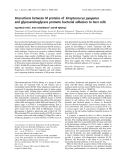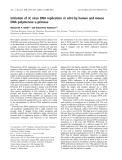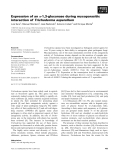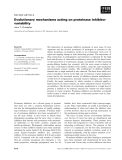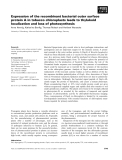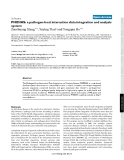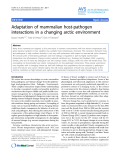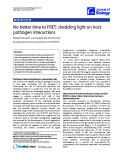
Host pathogen interactions
-
Several microbial pathogens have been reported to interact with glycosaminoglycans (GAGs) on cell surfaces and in the extracellularmatrix. Herewe demonstrate thatM protein, a major surface-expressed virulence factor of the human bac-terial pathogen, Streptococcus pyogenes, mediates binding to various forms of GAGs. Hence, S. pyogenesstrains expressing a large number of different types of M proteins bound to dermatan sulfate (DS), highly sulfated fractions of heparan sulfate (HS) and heparin, whereas strains deficient in M protein surface expression failed to interact with these GAGs. ...
 9p
9p  fptmusic
fptmusic
 16-04-2013
16-04-2013
 47
47
 6
6
 Download
Download
-
Host species specificity of the polyomaviruses simian virus 40 (SV40) and mouse polyomavirus (PyV) has been shown to be determined by the host DNA polymerase a-primase complex involved in the initiation of both viral and host DNA replication. Here we demonstrate that DNA repli-cation of the related human pathogenic polyomavirus JC virus (JCV) can be supportedin vitro by DNA polymerase a-primase of either human or murine origin indicating that the mechanism of its strict species specificity differs from that of SV40 and PyV.
 8p
8p  fptmusic
fptmusic
 16-04-2013
16-04-2013
 44
44
 3
3
 Download
Download
-
Trichodermaspecies have been investigated as biological control agents for over 70 years owing to their ability to antagonize plant pathogenic fungi. Mycoparasitism, one of the main mechanisms involved in the antagonistic activity ofTrichodermastrains, depends on the secretion of complex mix-tures of hydrolytic enzymes able to degrade the host cell wall. The antifun-gal activity of an a-1,3-glucanase (EC 3.2.1.59, enzymes able to degrade a-1,3-glucans and also named mutanases) has been described in T. harzia-num and its role in mycoparasitic processes has been suggested....
 0p
0p  awards
awards
 05-04-2013
05-04-2013
 44
44
 4
4
 Download
Download
-
The interaction of proteinase inhibitors produced, in most cases, by host organisms and the invasive proteinases of pathogens or parasites or the dietary proteinases of predators, results in an evolutionary ‘arms race’ of rapid and ongoing change in both interacting proteins.
 13p
13p  dell39
dell39
 27-03-2013
27-03-2013
 44
44
 4
4
 Download
Download
-
Bacterial lipoproteins play crucial roles in host–pathogen interactions and pathogenesis and are important targets for the immune system. A promi-nent example is the outer surface protein A (OspA) ofBorrelia burgdorferi, which has been efficiently used as a vaccine for the prevention of Lyme dis-ease.
 10p
10p  media19
media19
 04-03-2013
04-03-2013
 39
39
 3
3
 Download
Download
-
Tuyển tập các báo cáo nghiên cứu về y học được đăng trên tạp chí y học Wertheim cung cấp cho các bạn kiến thức về ngành y đề tài: Draft genome sequence of the Daphnia pathogen Octosporea bayeri: insights into the gene content of a large microsporidian genome and a model for host-parasite interactions...
 0p
0p  thulanh21
thulanh21
 15-11-2011
15-11-2011
 61
61
 2
2
 Download
Download
-
Tuyển tập các báo cáo nghiên cứu về y học được đăng trên tạp chí y học Critical Care giúp cho các bạn có thêm kiến thức về ngành y học đề tài: PHIDIAS: a pathogen-host interaction data integration and analysis system...
 15p
15p  thulanh19
thulanh19
 05-11-2011
05-11-2011
 38
38
 2
2
 Download
Download
-
Tuyển tập các báo cáo nghiên cứu về bệnh học thý y được đăng trên tạp chí Acta Veterinaria Scandinavica cung cấp cho các bạn kiến thức về bệnh thú yđề tài: Adaptation of mammalian host-pathogen interactions in a changing arctic environment...
 8p
8p  coxanh_1
coxanh_1
 22-10-2011
22-10-2011
 42
42
 5
5
 Download
Download
-
Tuyển tập các báo cáo nghiên cứu về sinh học được đăng trên tạp chí sinh học Journal of Biology đề tài: No better time to FRET: shedding light on host pathogen interactions...
 4p
4p  toshiba4
toshiba4
 07-09-2011
07-09-2011
 58
58
 4
4
 Download
Download
CHỦ ĐỀ BẠN MUỐN TÌM








